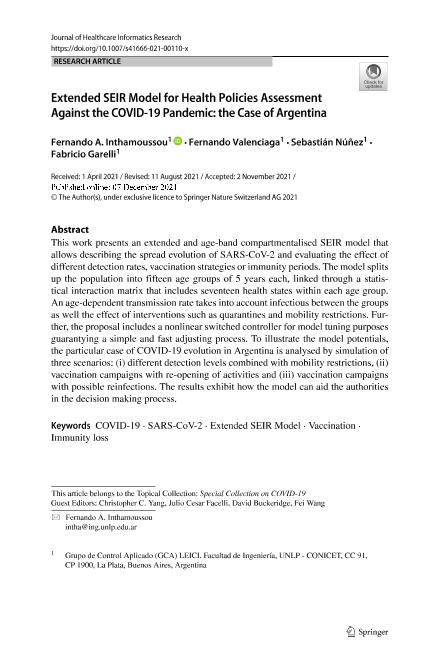Artículo
Extended SEIR Model for Health Policies Assessment Against the COVID-19 Pandemic: the Case of Argentina
Fecha de publicación:
12/2021
Editorial:
Springer
Revista:
Journal of Healthcare Informatics Research
ISSN:
2509-4971
e-ISSN:
2509-498X
Idioma:
Inglés
Tipo de recurso:
Artículo publicado
Clasificación temática:
Resumen
This work presents an extended and age-band compartmentalised SEIR model that allows describing the spread evolution of SARS-CoV-2 and evaluating the effect of different detection rates, vaccination strategies or immunity periods. The model splits up the population into fifteen age groups of 5 years each, linked through a statistical interaction matrix that includes seventeen health states within each age group. An age-dependent transmission rate takes into account infectious between the groups as well the effect of interventions such as quarantines and mobility restrictions. Further, the proposal includes a nonlinear switched controller for model tuning purposes guarantying a simple and fast adjusting process. To illustrate the model potentials, the particular case of COVID-19 evolution in Argentina is analysed by simulation of three scenarios: (i) different detection levels combined with mobility restrictions, (ii) vaccination campaigns with re-opening of activities and (iii) vaccination campaigns with possible reinfections. The results exhibit how the model can aid the authorities in the decision making process.
Palabras clave:
COVID-19
,
EXTENDED SEIR MODEL
,
IMMUNITY LOSS
,
SARS-COV-2
,
VACCINATION
Archivos asociados
Licencia
Identificadores
Colecciones
Articulos(LEICI)
Articulos de INSTITUTO DE INVESTIGACIONES EN ELECTRONICA, CONTROL Y PROCESAMIENTO DE SEÑALES
Articulos de INSTITUTO DE INVESTIGACIONES EN ELECTRONICA, CONTROL Y PROCESAMIENTO DE SEÑALES
Citación
Inthamoussou, Fernando Ariel; Valenciaga, Fernando; Nuñez, Sebastián; Garelli, Fabricio; Extended SEIR Model for Health Policies Assessment Against the COVID-19 Pandemic: the Case of Argentina; Springer; Journal of Healthcare Informatics Research; 12-2021; 1-21
Compartir
Altmétricas




